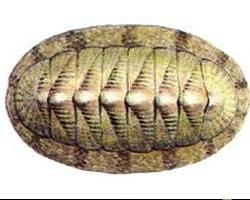
Súlyok és méretek
| Hossz | 3-tól 5-ig cm |
|---|
Veszélyeztetettség
| Veszélyeztetett |
Állatleírás
The Green Chiton, scientifically named Chiton olivaceus, is a captivating marine mollusk belonging to the class Polyplacophora. These creatures are primarily found in the temperate and tropical waters, making their homes on rocky shores, where they can often be seen clinging tightly to the surface of rocks or hiding in crevices to avoid predators. The green chiton has a unique and distinctive appearance, which, along with its habitat and behavior, makes it a fascinating subject of study.The most striking feature of the Green Chiton is its protective shell, which consists of eight articulated plates. These plates allow the chiton to curl up into a ball when threatened, providing protection from predators. The color of these plates is where the Green Chiton gets its common name, as they typically exhibit various shades of green, ranging from olive to dark green, sometimes intermixed with browns or yellows. This coloration not only gives the Green Chiton its name but also provides a level of camouflage against the algae-covered rocks of its habitat.
Beneath the armor-like plates, the Green Chiton's body is soft and muscular. This muscular foot is used for locomotion, enabling the chiton to move slowly across the rock surfaces as it grazes on algae and biofilms. The Green Chiton has a rather primitive nervous system and lacks true eyes, but it possesses photoreceptor cells that allow it to detect changes in light, helping it navigate its environment and avoid potential threats.
One of the most interesting aspects of the Green Chiton's biology is its feeding habits. Equipped with a specialized rasping tongue known as a radula, the Green Chiton is able to scrape algae off rocks with remarkable efficiency. This radula contains rows of tiny, hard teeth made of magnetite, one of the hardest materials produced by any organism. This adaptation allows the Green Chiton to feed on a variety of algae, including those that are too tough for many other marine herbivores.
Reproduction in Green Chitons is another area of interest. They are dioecious, meaning that individuals are distinctly male or female. Fertilization occurs externally, with females releasing eggs and males releasing sperm into the water column. The resulting larvae are free-swimming and will eventually settle onto a suitable surface, where they undergo metamorphosis into their adult form.
Green Chitons play a significant role in their ecosystem. By grazing on algae, they help to control algal growth, maintaining a balance that benefits a wide range of marine species. Furthermore, they serve as a food source for a variety of predators, including sea stars, crabs, and fish.
Despite their resilience and adaptability, Green Chitons face threats from pollution, habitat destruction, and climate change. Rising ocean temperatures and acidification pose significant challenges to their survival, potentially affecting their ability to calcify their protective plates.
In conclusion, the Green Chiton, Chiton olivaceus, is a remarkable creature that exemplifies the diversity and complexity of marine life. Its unique adaptations, from the armored plates that provide protection to the radula used for feeding, make it an intriguing subject for study and conservation. As a key player in its ecosystem, understanding and preserving the Green Chiton is essential for maintaining the health and biodiversity of marine environments.
Új állatfotók
Top 10 állat
- Diana monkey (Cercopithecus diana)
- Dolphin gull (Leucophaeus scoresbii)
- Galápagos tortoise (Geochelone nigra complex)
- Moustached guenon (Cercopithecus cephus)
- Japanese spider crab (Macrocheira kaempferi)
- Colossal squid (Mesonychoteuthis hamiltoni)
- Stone loach (Barbatula barbatula)
- Common house mosquito (Culex pipiens)
- Common reed warbler (Acrocephalus scirpaceus)
- Sea urchins (Echinoidea)